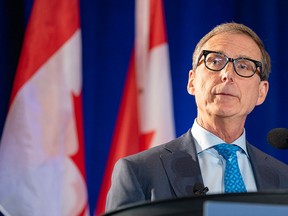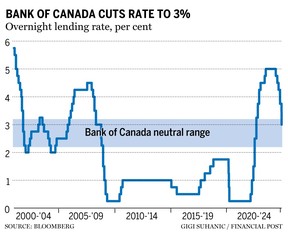Bank of Canada cuts interest rate to 3% amid trade uncertainty with the United States

Central bank warns economic consequences of a prolonged trade war could be severe

Article content
The Bank of Canada cut its policy interest rate by 25 basis points to three per cent on Wednesday, while warning that the economic consequences of a prolonged trade war with the United States could be severe, hindering growth while potentially reigniting inflation.
Article content
Article content
Bank of Canada governor Tiff Macklem noted that while inflation has held near the bank’s two per cent target since August and household spending is picking up, the potential for a trade conflict with the United States has clouded the economic and inflation outlooks.
Advertisement 2
Story continues below
Article content
“A long-lasting and broad-based conflict would badly hurt economic activity in Canada,” Macklem said. “At the same time, the higher cost of imported goods will put direct upward pressure on inflation.”

U.S. President Donald Trump has said he would impose 25-per-cent tariffs on Canada and Mexico as early as this Saturday.
The central bank ran through a number of tariff scenarios in its monetary policy report, which was released following the interest rate decision on Wednesday. In its “benchmark calibration,” which assumes price changes in line with patterns observed with previous tariffs, a 25-per-cent U.S. tariff on all imported goods and subsequent equal retaliation from trading partners, would lead to a hit of 2.5 percentage points to Canada’s gross domestic product (GDP) at the end of the first year.
A second scenario assumes there is a larger decline in U.S. demand for Canadian goods, which would lead to a hit of three percentage points to Canadian economic growth. All scenarios would mean an increase in CPI inflation in Canada and the U.S. over a three-year period.
Article content
Advertisement 3
Story continues below
Article content
“Unfortunately, tariffs mean economies simply work less efficiently — we produce and earn less than without tariffs,” said Macklem. “Monetary policy cannot offset this. What we can do is help the economy adjust.”
Macklem added the central bank only has one policy instrument, its interest rate, which can’t address both weaker output and higher inflation at the same time.
“This is a complex shock for monetary policy, because growth will be weaker, inflation will be higher,” Macklem said during a press conference with reporters in Ottawa. “We are going to be assessing the relative weight of those two.”
Missing from the Bank of Canada’s policy statement and the governor’s opening remarks was any guidance on the future path of interest rates.
“There is a lot of uncertainty out there and it just didn’t seem very useful to provide guidance,” added Macklem. “We don’t know what the U.S. is going to do, and even when we do know more, we’re going have to some more work to figure out exactly how that’s going to play out in the economy.”
Watch the Bank of Canada press conference here
Advertisement 4
Story continues below
Article content
David Rosenberg, founder and president of Rosenberg Research & Associates Inc., said future markets are pricing in just a 60 per cent chance of another cut in March.
“For year-end, the markets are braced for the overnight rate to drop to 2.5 per cent from three per cent currently,” Rosenberg said in a note to clients.
Douglas Porter, chief economist at the Bank of Montreal, thinks the central bank will eventually have to cut the policy rate further in a trade war scenario.
“Today’s steps by the Bank of Canada can be viewed as battening down the hatches ahead of a possible trade-war storm,” he said in a note. “Next steps clearly are dependent on what unfolds on the trade front; we suspect while the bank may initially respond cautiously to a trade war, eventually it would be compelled to cut much more than the market currently expects.”
James Orlando, senior economist at Toronto-Dominion Bank, said he remains hopeful that the tariffs are a negotiation tactic, but in the event of their application, the central bank would have to cut more in response.
“This is a tail risk that remains front and centre in the mind of the Bank of Canada,” he said in a note. “Our baseline forecasts remains that the Bank of Canada will cut rates to 2.25 per cent by year-end, but should 25-per-cent tariffs come into play for more than a few months, we’d expect the central bank to cut more aggressively in order to cushion the economy.”
Advertisement 5
Story continues below
Article content
Absent tariffs, the central bank revised down its previous GDP projection from 2.1 per cent growth in 2025 to 1.8 per cent, due mainly to reduced immigration targets introduced by the federal government in the fall, but also a decrease in investment sentiment in Canada because of the threat of tariffs.
“In Canada, there are already signs that the threat of tariffs is weighing on consumer and business confidence and investment intentions,” the monetary policy report said. “This threat has also contributed to the recent depreciation of the Canadian dollar.”
The bank expects inflation to remain around the two per cent target over the next two years, with temporary effects caused by suspension of the HST/GST wearing off in March when the tax holiday comes to an end.
Recommended from Editorial
The bank also addressed concerns over the depreciation of the Canadian dollar. While it acknowledged the widening differential between interest rates in Canada and the U.S. has had some impact, it said the main cause of the depreciation has been driven by the foreign exchange premium due to the uncertainty brought on by the threat of U.S. tariffs.
“The recent depreciation that we’ve seen in the Canadian dollar has been more driven in our view by trade uncertainty,” Macklem said.
The central bank also announced the end of quantitative tightening and adjusted the deposit rate to a spread of five basis points below the bank’s policy rate.
• Email: jgowling@postmedia.com
Bookmark our website and support our journalism: Don’t miss the business news you need to know — add financialpost.com to your bookmarks and sign up for our newsletters here.
Article content








Comments